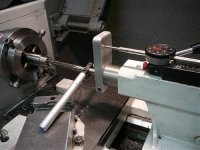Chambering by hand
As a Benchrest Shooter, and Machinist, I am one of those who chamber by hand. I rough bore the chamber, on the correct taper, to where all I am using the reamer for is to establish the final size, shape, and finish of the chamber.
I have my own reasons for doing this. In fact, on my Benchrest Rifles, I do things a little backwards. I establish the best chamber I can in the barrel first, then I do all of the other machining operations, basing all of the criticle dimensions off of that chamber..
But, I do not do Gunsmith work for a living. And, the biggest thing I will ever encounter in the size of a chamber is a 308. If I were doing this for a living, I would certainly be using one of the tried and true methods that Masters such as Dave Tooley employ.
Gunsmithing, to me, is a hobby. I can spend as much time as I want doing one of my own barrels. But, since I also own and run a Marine Repair Machine Shop, I know that time is money. You can only dedicate a certain amount of time for any job, because there is a set price that the market dictates. It might sound cool to say, "I take all day to ream a chamber if neccessary', but if you do, you will be working for sub minimum wage.
Master Gunsmiths, who do thousands of chambers, use methods that produce the very best results in a reasonable amount of time. The excellence of their work does not suffer because they have developed set-ups that guarantee the finest reasults in a timely fashion.........jackie


